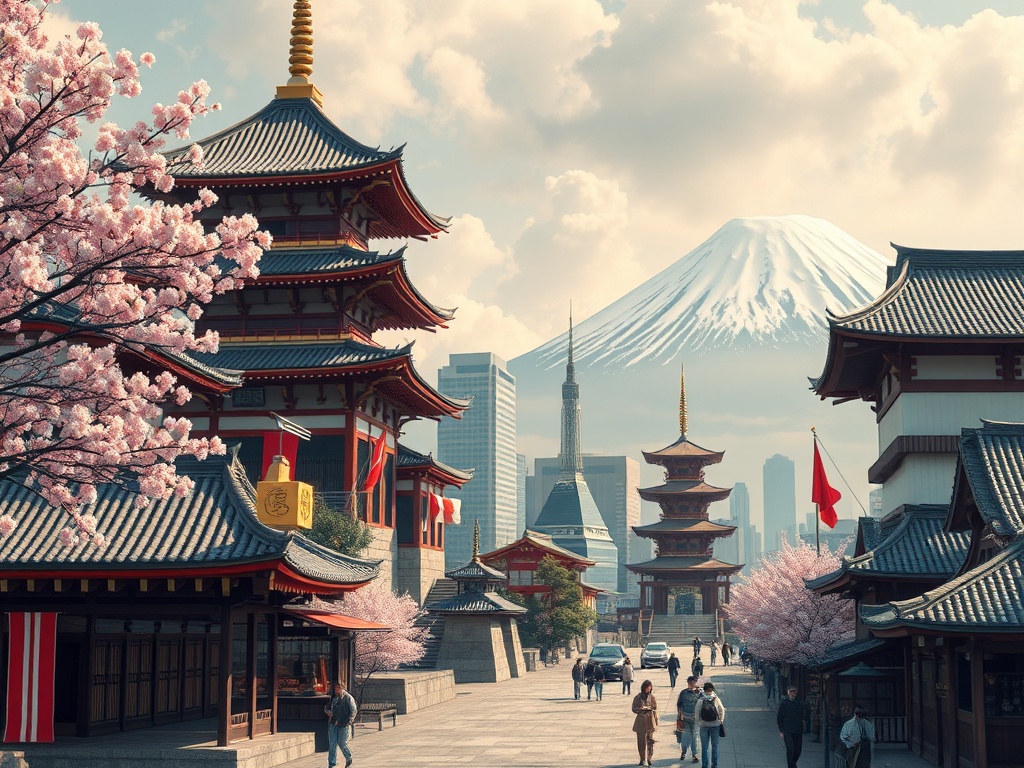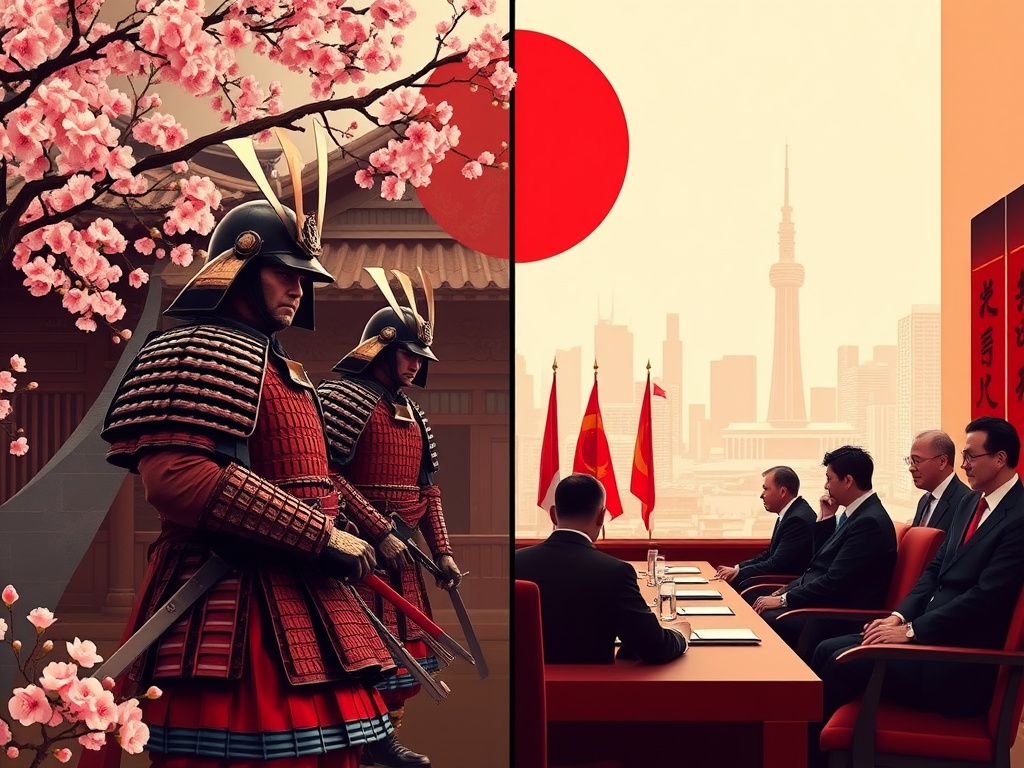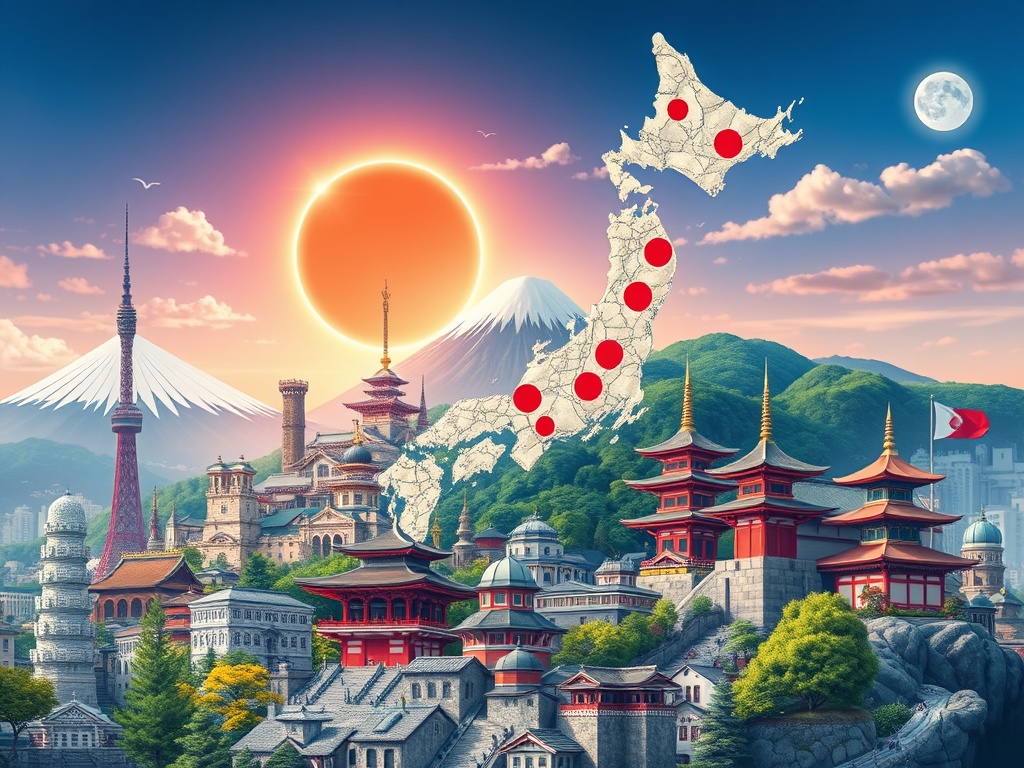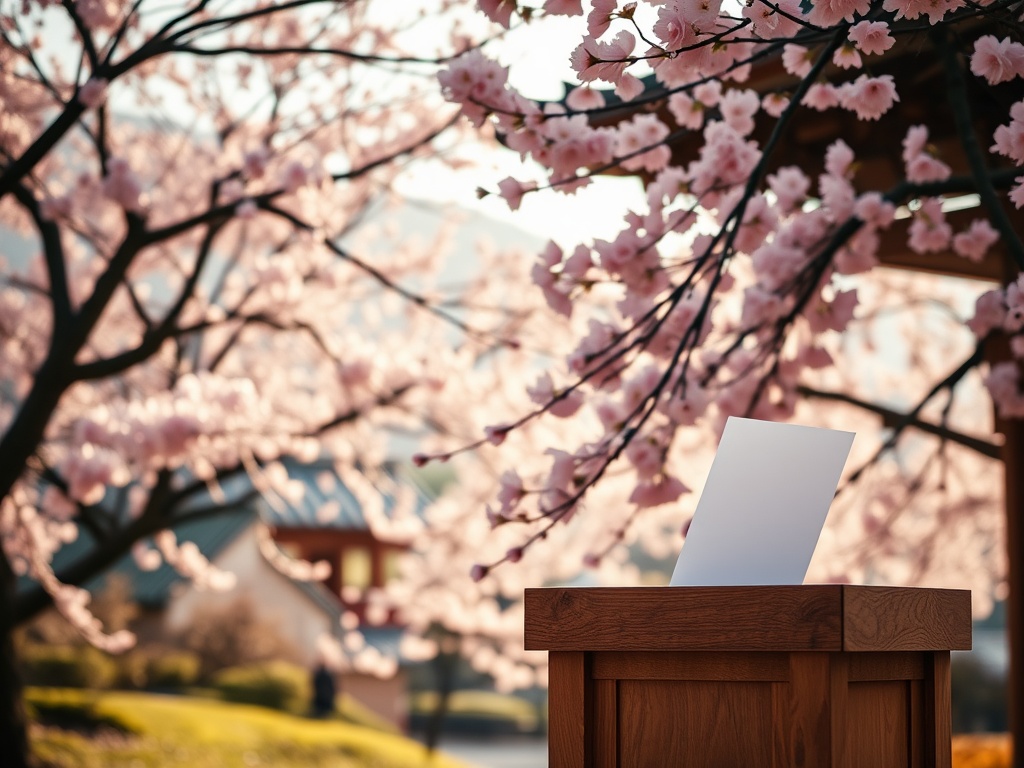From Samurai to Statesmen: The Evolution of Japan’s Political Landscape
Win a Free Trip to Japan!
Experience cherry blossoms and ancient temples
Japan’s political narrative is as rich and varied as its cultural tapestry, drawing travelers not only to its cherry blossoms and sushi but also to its fascinating transformation from feudal domains to a modern democracy. For those journeying through Japan, understanding its political evolution offers a deeper appreciation of its history, culture, and societal norms.
In the shadow of the majestic Mount Fuji, the political roots of Japan were once deeply embedded in the feudal systems dominated by powerful samurai clans. The Daimyo—regional lords—wielded immense power, ruling their lands with an iron fist, only answerable to the Shogun. The Edo period, characterized by peace and isolation, saw these warriors transform into bureaucrats. However, the winds of change came with the arrival of Commodore Perry’s black ships in 1853, prompting Japan to open its doors to the world.
The Meiji Restoration of 1868 was a pivotal turning point, as Emperor Meiji dismantled the shogunate, centralizing power and ushering in a wave of modernization. This era saw the rise of a constitutional monarchy, the establishment of a parliamentary system, and the modernization of industry and military, laying the groundwork for a new Japan.
After the devastation of World War II, Japan’s political landscape was reshaped under the guidance of Allied occupation. The post-war period was marked by a series of reforms that would redefine the nation’s governance and societal structure. In 1947, a new constitution was enacted, establishing a democratic framework that emphasized pacifism and human rights.
Guided by the principles of democracy, Japan’s political system evolved into a vibrant parliamentary democracy, characterized by the formation of political parties and a shift towards liberal policies. The Liberal Democratic Party (LDP) emerged as a dominant force, presiding over a period of economic boom and technological advancement.
Today’s Japan is a fascinating blend of traditional values and modern political dynamics, attracting tourists eager to explore its complex identity. The political spectrum now includes a variety of parties ranging from conservative to progressive, each contributing to a dynamic discourse that shapes Japan’s policies and global stance.
- Key Political Parties in Modern Japan:
- Liberal Democratic Party (LDP): Known for its conservative policies and long-standing influence in Japanese politics.
- Constitutional Democratic Party (CDP): A progressive party advocating for social equality and constitutional reforms.
- Komeito: A party promoting peace and social welfare, often aligning with the LDP in coalition governments.
While wandering through the bustling streets of Tokyo or the serene gardens of Kyoto, travelers can witness the echoes of Japan’s political evolution, from samurai legacies to the statesmen shaping its future.
Beyond Tokyo: Regional Political Flavors in Japan’s Prefectures
While Tokyo serves as a vibrant political hub and the heartbeat of Japan’s national governance, a captivating political mosaic thrives across its diverse regions. Each prefecture offers a unique political flavor, reflecting the rich tapestry of local history, culture, and economic priorities. For the curious traveler, delving into these regional political dynamics offers an enriching perspective on the nation’s complex identity.
Kyushu, an island known for its volcanic landscapes and onsen, also boasts dynamic political currents that lean towards progressive ideals. The region often champions policies that emphasize environmental sustainability and renewable energy, driven by its abundant natural resources. Tourists visiting Fukuoka or Nagasaki can witness firsthand the innovative approaches to urban development and community-driven initiatives that highlight the region’s forward-thinking ethos.
In contrast, the vast northern landscapes of Hokkaido present a different political narrative, one deeply intertwined with agriculture and rural development. Here, political priorities are often shaped by the needs of the farming communities and the preservation of natural habitats. When exploring the scenic beauty of Sapporo or the picturesque towns of Biei, travelers can gain insights into how local governance balances economic growth with environmental conservation, reflecting a political stance that prioritizes harmony with nature.
The regional political flavors of Japan’s prefectures provide a fascinating backdrop to the nation’s broader political spectrum. As travelers journey beyond the bustling metropolis of Tokyo, they are invited to engage with the unique and diverse political landscapes that shape Japan’s identity, offering a deeper understanding of its evolving democracy.
Cherry Blossoms and Ballot Boxes: How Culture Influences Japanese Politics
When one thinks of Japan, images of delicate cherry blossoms, ancient shrines, and the tantalizing aroma of street-side ramen might come to mind. However, beneath these cultural symbols lies a political landscape that is profoundly shaped by Japan’s rich cultural heritage. For travelers eager to understand Japan’s societal norms and political nuances, diving into how culture intertwines with politics offers an enlightening journey.
Japan’s political climate cannot be fully appreciated without acknowledging the cultural underpinnings that drive civic engagement. The concept of harmony, or wa, deeply rooted in Japanese culture, influences political discourse and decision-making. This cultural value emphasizes consensus and collective well-being, guiding political processes to favor dialogue and cooperation over confrontation. As travelers explore the serene gardens and bustling markets, they witness a society where political decisions often reflect a deep-seated respect for harmony and order.
While Japan embraces modernity, it simultaneously cherishes its traditions, creating a unique blend in its political policies. Cultural events such as cherry blossom festivals not only celebrate nature but also serve as a reminder of Japan’s seasonal cycles and the importance of nature in its political agenda. Environmental policies, often inspired by the cultural reverence for nature, aim to preserve this delicate balance. Tourists participating in traditional festivals or visiting historic sites can observe how these cultural elements are woven into policy-making, from urban planning to environmental conservation efforts.
The interplay between culture and politics in Japan is intricate and fascinating, providing travelers with a deeper understanding of a society that seamlessly blends the past with the present. As they stroll under the cherry blossoms or engage in local customs, visitors gain insight into how Japan’s cultural identity shapes its political landscape, creating a truly unique and harmonious democracy.
Rising Suns and Shifting Tides: The Future of Japan’s Political Parties
While Japan stands as a beacon of rich tradition and modern innovation, its political landscape is equally dynamic, constantly evolving in response to both domestic and global challenges. For the intrepid traveler diving into Japan’s political scene, the shift and emergence of new political forces provide a captivating narrative of change and adaptability. As the Land of the Rising Sun moves forward, its political parties are poised to navigate a future teeming with opportunities and challenges.
In recent years, Japan has witnessed the rise of new political movements that seek to address contemporary issues like climate change, digital innovation, and demographic shifts. These emerging parties are challenging the status quo, infusing the political arena with fresh perspectives and innovative solutions. Travelers visiting the vibrant streets of Osaka or the coastal beauty of Okinawa may encounter grassroots movements and public forums that offer a local glimpse into these evolving political dynamics.
- Renewable Energy Advocates: With Japan’s commitment to sustainability, parties focusing on renewable energy solutions are gaining traction, pushing for policies that harness technological advancements in solar and wind energy.
- Digital Revolutionaries: As technology continues to reshape the global landscape, parties advocating for digital transformation and cybersecurity are emerging, appealing to younger, tech-savvy demographics.
The youth of Japan are playing an increasingly pivotal role in shaping the political discourse, driven by their unique perspectives and aspirations for the future. This generational shift is infusing the political spectrum with new ideas, from education reforms to economic policies that resonate with a globalized world. Travelers exploring bustling university towns like Kyoto or Sendai will find energetic campaigns and youthful activism, reflecting a society eager to redefine its future.
The evolving presence of youth in politics is not only reshaping party priorities but also challenging traditional power structures, paving the way for a more inclusive and diverse political landscape. As these young leaders rise, they bring with them a transformative vision for Japan, one that embraces innovation while respecting cultural heritage.
Tea Ceremonies and Town Halls: The Intersection of Tradition and Modern Governance
Japan offers an intriguing juxtaposition where ancient traditions seamlessly coexist with modern governance. For those exploring this vibrant nation, the cultural richness extends beyond the renowned temples and geisha districts, delving into the subtle yet profound ways in which tradition influences contemporary political practices. This blend is most vividly seen in the dynamic interplay between traditional tea ceremonies and modern-day town halls, reflecting a society that values both its historical roots and its democratic future.
While traveling through Japan, one might observe that the fundamental principles of the tea ceremony are mirrored in the country’s political discourse. This ancient ritual, with its emphasis on precision, respect, and harmony, serves as a metaphor for the careful and considerate decision-making processes in Japanese politics. In traditional tea rooms, every movement is deliberate, fostering an environment of calm deliberation and mutual respect. Similarly, in political arenas, these values guide discussions and negotiations, promoting a culture where consensus is prioritized over conflict.
Visitors participating in a tea ceremony in Kyoto or Nara will gain insight into how these cultural practices subtly inform political behaviors, offering a unique perspective on how Japan navigates the complexities of modern governance while honoring its heritage. The tea ceremony’s influence can be seen in the structured and courteous nature of political debates and the emphasis on community consensus, echoing the ceremonial pursuit of tranquility and balance.
As travelers venture into local town halls, they are met with a scene that, despite its modern facade, is deeply rooted in Japan’s communal traditions. Town halls across Japan serve as contemporary forums where citizens gather, much like in the communal spaces of old. Here, the spirit of the tea ceremony extends into civic engagement, where the community’s voice is both heard and respected. The layout of these forums, often informal and inviting, encourages open dialogue and ensures that all viewpoints are considered.
In cities like Osaka and rural prefectures such as Tottori, town hall meetings offer tourists a chance to witness firsthand the democratic processes at work. These gatherings are more than just political events; they are cultural experiences that highlight Japan’s commitment to maintaining harmony and cooperation within its civic spaces. Engaging with these meetings provides a deeper understanding of how Japan’s democratic practices are deeply interwoven with its cultural ethos, creating a political environment that is as respectful as it is progressive.
The Emperor’s Role: A Symbolic Heartbeat in Japan’s Political Spectrum
Travelers venturing into the intricate political landscape of Japan will find the role of the Emperor both intriguing and emblematic of the nation’s unique blend of tradition and modernity. While Japan’s political system is a vibrant democracy, the Emperor remains a symbolic figure, representing not only the continuity of the Japanese state but also its deep cultural heritage.
For centuries, the Emperor of Japan has held a position of reverence, bridging the past with the present. Unlike monarchs in some other nations, the Japanese Emperor has no governing power but serves as a cultural and spiritual figurehead. This role is deeply rooted in Shinto beliefs, where the Emperor is considered a descendant of the sun goddess Amaterasu. Visitors exploring the sacred grounds of the Imperial Palace in Tokyo are drawn into a historical narrative that speaks volumes about Japan’s enduring traditions.
The Emperor’s duties are largely ceremonial, such as attending state functions and participating in rituals that celebrate Japan’s national identity. These public appearances are not merely formalities but are imbued with cultural significance, offering travelers a glimpse into the symbolic heartbeat that the Emperor represents in Japanese society.
The Emperor’s influence extends beyond political symbolism, permeating Japan’s cultural landscape through various ceremonial duties. Events like the New Year’s Greeting and the enthronement ceremony are steeped in tradition, drawing both locals and tourists keen to witness these grand spectacles. Such ceremonies serve to reinforce the unifying role of the Emperor as a custodian of Japan’s national identity. For those attending, these events offer a fascinating window into the cultural tapestry that interweaves with Japan’s political spectrum.
While the Emperor’s role is largely symbolic, it is essential in understanding Japan’s political spectrum. It showcases the delicate balance between modern governance and the respect for historical continuity that defines the nation. Thus, for travelers, the presence of the Emperor is a reminder of the rich cultural heritage that remains at the core of Japan’s identity.



